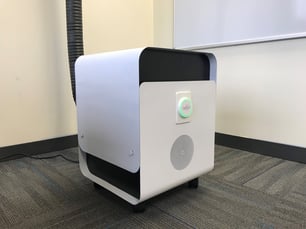Throughout the COVID-19 pandemic, the residents of long-term care facilities, senior living communities, and nursing homes have been one of the most impacted populations. With many at risk people living in single buildings or communities, as soon as one person becomes infected with COVID-19 the likelihood of the disease spreading among the community increases. Because COVID-19 is an airborne infection, understanding how to properly isolate an infected person from others can help increase the safety and reduce the risk of spreading the disease.
Introduction to Airborne Infection Isolation Rooms
Airborne Infection Isolation Rooms are single occupant hospital rooms designed to prevent the spread of contagious disease using negative pressure. The negative air pressure pulls clean air into the room, keeps the air inside the isolation space, and prevents pathogens from escaping into the surrounding areas. The contaminated air in the isolation space is then exhausted outside instead of being recirculated through the main HVAC system. The Airborne Infection Isolation Room has been a key aspect of the COVID-19 responses across hospitals and healthcare systems.
Traditionally, isolation rooms are set up via manipulation of a building’s HVAC system to control the airflows into and around the isolation room. Applications outside of hospitals are not typically built with HVAC systems that can easily create negative pressure and creating negative pressure isolation spaces involves lengthy and expensive HVAC construction projects.
Using the Setra AIIR Watch to Create Negative Pressure
 Creating negative pressure isolation rooms in long-term care facilities is made much easier with Setra AIIR Watch. Setra's AIIR Watch is compact and on wheels so it can be easily brought into a space that was not originally designed to be an isolation room and turn it into a negative pressure isolation space. Bringing AIIR Watch into the sick resident’s room means that resident does not need to be moved around the facility, and the negative pressure isolation immediately works to prevent contaminated air from escaping into hallways, common areas, and other residents’ rooms.
Creating negative pressure isolation rooms in long-term care facilities is made much easier with Setra AIIR Watch. Setra's AIIR Watch is compact and on wheels so it can be easily brought into a space that was not originally designed to be an isolation room and turn it into a negative pressure isolation space. Bringing AIIR Watch into the sick resident’s room means that resident does not need to be moved around the facility, and the negative pressure isolation immediately works to prevent contaminated air from escaping into hallways, common areas, and other residents’ rooms.
Once inside the space, Setra AIIR Watch plugs into any standard wall outlet and pulls the air in at 350 CFM. The air is then run through the combination of a HEPA filter and UV-C lights inside the unit, sterilizing the air to 99.99% effectiveness against viruses and bacteria—certified via a National Recognized Testing Laboratory (NRTL). The sterilized air is then safely exhausted out of the room, which creates the negative pressure.
Cleaned air from AIIR Watch can be exhausted in three different ways depending on what is available in the space. The first way is to exhaust the air out of a window with the provided hose and adjustable vent panel. The second option is to vent the sterilizes air up through a ceiling tile into the space above the ceiling. This can also be achieved with the provided exhaust hose and adjustable vent panel. Third, the exhaust can be connected directly to the existing HVAC system exhaust via the single exhaust hose on AIIR Watch unit. For this, it is recommended to contact an HVAC professional to properly incorporate AIIR Watch exhaust into the HVAC system.
It is essential for long-term care facilities, senior living communities, and nursing homes to have fast, effective plans for isolating someone in their community with a contagious disease. Coronavirus is top of mind currently but mitigating risk around the spread of airborne infections like Influenza, Pneumonia, and others can be achieved with effective isolation. The nursing homes and long-term care facilities across North America that have installed Setra AIIR Watch are able to confidently share with residents, visitors, and staff that they are creating the safest possible isolation spaces for their communities.


